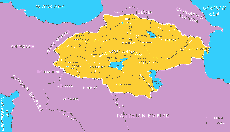Arsacid dynasty of Iberia
The dynasty of the Arsacid Iberian ( Georgian: არშაკიანი Aršakiani, or არშაკუნიანი, Aršakuniani ) was a branch of the eponymous Parthian Arsacid that prevailed in ancient Georgian Kingdom of Iberia of about 189-284 and which was followed by the Chosroiden dynasty.
History
After the Arsacid under Vologaeses V (reigned 180-191 ) had consolidated their rule on the Armenian throne 180, they got the opportunity to interfere in Iberia. According to the medieval Georgian chronicles, the king of Armenia, Professor Cyril Toumanoff with Vologases helped II equated to overthrow the rebellious nobles in Iberia his brother the last ruler of the Parnawasiden Amazasp II, and I. him by his own son Rew, whose reign 189-216 the Arsacid dynasty in Iberia founded to replace.
The Arsacids were in their country of origin, overthrown by the more powerful and dynamic Sassanid dynasty in 226, even though the Arsacids with Iran still had three other Caucasian kingdom (Armenia, Iberia and Albania ). Although the later Georgian chronicles of this change of power, the contributions to the concern period are full of anachronisms and provide semi-legendary allusions, few or no details of the effect of Iran's resurrection on the Iberian Arsakiden. What is known about the period, derived from classical sources as well as from Sassanid inscriptions.
By replacing the weak, more federally oriented Parthian empire by a strong and centralized state, the Sassanids changed the political orientation of the pro-Roman Iberia and reduced it to a vassal state dependent. Shapur I (reigned 242-272 ) continued his vassals Amazaspus III. (r. 260-265 ) on the throne of Iberia, possibly as a rival or rival king to Mihrdat II With the death of Aspagur II in 284, the line of the Arsacid Iberian died out, and the Sassanids took advantage of a civil war in the Roman Empire from to their candidate Mirian III. put of the dynasty of Chosroiden to the throne.









